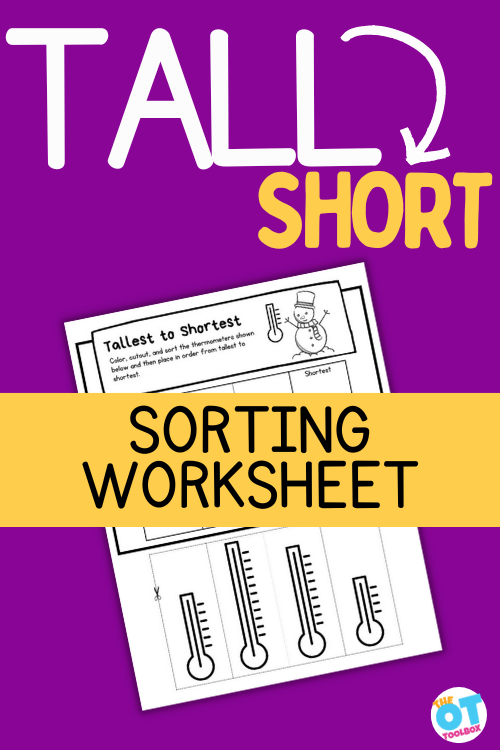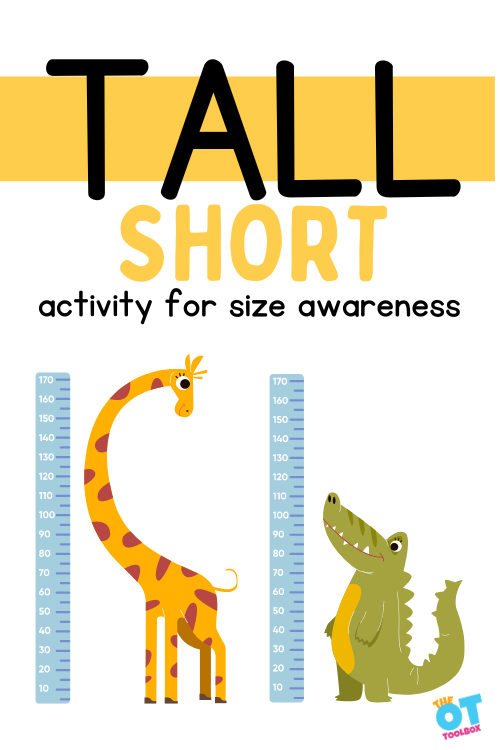Today, I have a great tall and short worksheet…or maybe you would call it a sorting by size worksheet. This activity is a cut and paste worksheet that users can color, cut, and sort by size to address a variety of skills all while incorporating spatial concepts of tall and short. We’ll cover those areas below as a tool to work on size awareness, sequencing, cognitive skills, and fine motor skills. Add this size sorting resource to your list of winter fine motor activities!

Tall and Short Worksheets
This winter cut and paste worksheet is a fun one that we’ve had in the OT Toolbox Member’s Club resource library since last year. For children, dissecting the differences between tall and short worksheet can support spatial awareness skills.
Spatial awareness, or awareness of the spatial area that objects or the individual takes up in space, as well as awareness of size and positioning, support so many aspects of functional performance.
Why use a tall and short worksheet?
Not only does this impact body awareness, the concept of sizing activities such as this tall and short worksheet can help young learners in several ways:
- Understanding body awareness as they relate to size of objects
- Organizing and sorting information
- Taking in information about the world around them and using that information in functional tasks
- Relating tall and short concepts to functional tasks such as handwriting
- Understanding differences between tall letters, small letters, and tail letters in handwriting. Read this resource on letter size for more information.
How does body awareness work?
Body awareness refers to being aware of the body’s position in space at rest and during movement. This concept can be broken down into several concepts:
- Having an awareness of body parts by name
- Movement and how the body moves through space and around objects
- discrimination of sides of the body
- Use of objects in the world around us
Self-awareness is a similar skill taking those same concepts into consideration, but adds on the emotional and cognitive aspects. This awareness allows for emotional regulation and behavioral that make up self-regulation. For some, these components of self-awareness are extremely difficult. When awareness of one’s preferences, tendencies, emotions, reactions, one can begin to understand their nee
Related, are the concepts of dominance and mixed dominance vs. ambidexterity.
There are many ways to use this tool to support skills. Let’s cover those below.
Hopefully you all made it unscathed through the holidays with some fun memories attached. We place such high expectations of ourselves and others during the holidays. I hope you spent time on self care, prioritizing what needed to be done versus what was just an extra chore.
It is time to get back into the swing of things for the new year. One way to jump back into functional goal practice is through creative and play-based activities centered around a fun theme like winter activities.
Just as during the rest of the year, lesson and treatment planning will be key to easing the load, goal accomplishment, and efficiency. The OT Toolbox, as anticipated, has great resources both free if you need one or two ideas, and for purchase if you are looking for a more comprehensive lesson plan.
This latest free printable does not disappoint. It’s a tall and short worksheet, where users can color, cut, and then sequence the sizes into an order that makes sense according to size.
This Winter Cut and Paste Tallest to Shortest worksheet will be a great activity to add to your winter theme and winter crafts.
This winter cut and paste worksheet is a nice printable if you are working on sorting by size, measurement, math concepts, classifying, cutting or gluing, to name a few.

How to use a Tall and Short worksheet
If you follow my posts on the OT Toolbox, you already know how flexible these worksheets are. If you are new, let me tell you how flexible they are! The thing is that occupational therapy practitioners like to use a single activity in many different ways to serve many clients on a caseload.
This Tall Short worksheet is so much more than a cut and paste task.
Print off the tall vs short worksheet (below) and then use it along with the activities listed below based on the needs of the users.
Use the tall-short worksheet to address just some of these important skills:
- Coloring inside the lines with full coverage
- Discuss tall vs. short
- Cutting on the line, within half inch of lines, in the direction of lines
- Pasting using glue stick or drippy glue with accuracy
- Ask questions about whether the objects are tall or short and then sort the objects in sequential order of height
- Measuring by size can be done by eye, with a ruler, or other manipulatives
- Categorizing tallest to shortest
- Categorizing shortest to tallest
- Sorting other objects from tall to short or short to tall
- Sort crayons, toys, blocks, etc. into tall, taller, tallest
- Sort crayons, toys, blocks, etc. into short, shorter, shortest
- Incorporate into measuring activities
- Place one small object on the shorted object. Then add one more object to each item as they get tall, taller, and tallest. Some ideas include: coins, play dough balls, beads, cotton balls, etc.
- Fine motor strengthening, hand development, and grasping pattern
- Core strength to sit at a table, with shoulder stability and wrist support
- Following directions, attention to detail, turn taking, waiting, social skills, compliance, behavior, and work tolerance
- Visual perceptual skills to determine visually which shape looks bigger than the others. Figure ground to be able to pick out these items from their background. Visual scanning to look at all of the shapes, visual attention to follow where the shapes are going to fit
- Bilateral coordination holding the paper with one hand while coloring, stabilizing and turning the paper for cutting skills
As part of your treatment plan, you could decide to focus on all of these objectives or just one or two.
There are times I might just want to focus on cutting skills, so I would add more help in the measurement section. If I am looking at social skills and following directions, my focus might not be on the quality of coloring at all, or minimally. If I need a math spin on it, perhaps I am not concerned about cutting, but measurement, size referencing, or classifying.
Modify a Tall Short Worksheet
How do I modify these tasks for varied learners? This is the key to an efficient work week. Using a handful of tasks for the whole week is much more productive than 40 different activities.
- Laminate the page and precut all the shapes to eliminate cutting and coloring
- Cut the shapes for the learner ahead of time, to eliminate cutting
- Print onto different colored or weighted paper for different visibility. Thicker paper adds to the stability when cutting, or it could improve hand strength cutting through thicker cardstock
- Provide different manipulatives for measuring and talking about the sizing of these thermometers
- Limit the amount of supplies on the table so your learner has to use social skills to ask for what they need, or share with peers
- For your lowest level learners, perhaps this just becomes a scribble and color page, working on attending to a task
- Add this sheet to other PDFs found on the OT Toolbox for a well rounded lesson plan such as the Food Alphabet Cut and Color book found here:
- Add sensory, gross motor, or other fine motor tasks, to address more skills.
How can I expand this task?
- Measure the temperature of water, versus ice or snow
- Talk about the winter weather in other parts of the world
- Use rulers, cubes, fingers, or other objects to measure the thermometers
- Read a book about winter temperatures or snowmen.
- Talk about personal experiences with cold temperatures or snow
- Add a sensory bin with real or fake snow, hiding items in the snow or creating something out of the snow
- Throw real or created snowballs to build arm strength
- Search OT Toolbox for plenty of winter activities for learners of all different levels
Free Tall Short Worksheet
If you love using printable tools to support skill development, why not consider becoming a member of The OT Toolbox Member’s Club? This is a new feature at the OT Toolbox offering members even more access to great tools and resources.
Or, access the printable tall short worksheet using the form below. Enter your email address into the form below and the tall short activity will be delivered to your email inbox.

Victoria Wood, OTR/L is a contributor to The OT Toolbox and has been providing Occupational Therapy treatment in pediatrics for more than 25 years. She has practiced in hospital settings (inpatient, outpatient, NICU, PICU), school systems, and outpatient clinics in several states. She has treated hundreds of children with various sensory processing dysfunction in the areas of behavior, gross/fine motor skills, social skills and self-care. Ms. Wood has also been a featured speaker at seminars, webinars, and school staff development training. She is the author of Seeing your Home and Community with Sensory Eyes.


